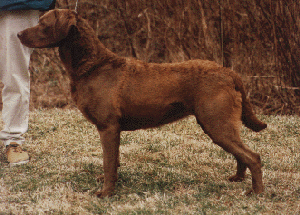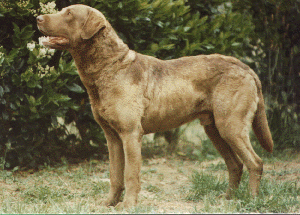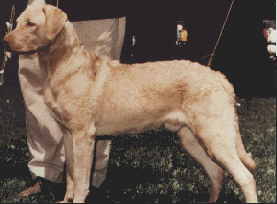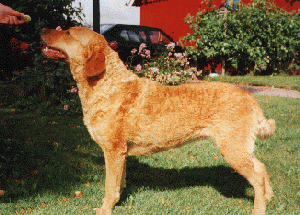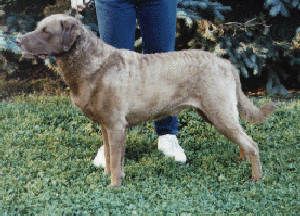Color in the Chesapeake Bay Retriever
Three basic colors are generally seen in the breed: Brown which includes all shades from a light cocoa (a silvered brown) to a deep bittersweet chocolate color; sedge which varies from a reddish yellow through a bright red to chestnut shades; deadgrass which takes in all shades of deadgrass, varying from a faded tan to a dull straw color.
Historic records show that some of the deadgrass shades can be very light, almost white in appearance, while darker deadgrass colors can include diluted shades of brown called ash, that appear as either gray or taupe. These ash/taupe/gray shades are not commonly seen and are not preferred. Eye color for these diluted shades, as with all coat colors, must be of yellowish or amber color. The difference between sedge and deadgrass is that the deadgrass shades contain no significant amount of red, while the sedge shades do have red. Coat and texture also play a factor in the perception of color.
The self-color pattern is preferred by the standard (one color with or without lighter and darker shadings of the same color). You will see dogs with varying degrees of other markings such as: masking on the top skull, striping effect of light & dark through the body and on legs, distinct & indistinct saddle markings, agouti coloring and tan points. While these patterns are not preferred, they should not be disqualified. Considering that color counts for only 4 points in the Chesapeake standard, dogs with such markings should not be arbitrarily excluded from consideration. The other qualities of the dog that are more important to function, such as coat, angulation, head, balance and size, should be given the most consideration when judging. A good quality dog with minor pattern variations may have more virtues to offer than a mediocre self-colored specimen. It is true that these coloration patterns, at times, can be very pronounced. There have been judges who have disqualified dogs because of these patterns under the “specimens lacking breed characteristics” disqualification. Please note that characteristics are plural and color alone is not sufficient to warrant the use of this disqualification. If the coloration patterns bother you to a great extent, then leave the dog unplaced or put it last.
There are only two color disqualifications in the breed – black-colored, and white on any part of the body except breast, belly, and toes or back of feet. The white disqualification seems to cause the most confusion. White, which extends above the point of the sternum, whether connected or unconnected to white below, is a disqualifying location. White can also appear farther up on the neck and is often difficult to see. It is suggested that you lift up the head and examine this area for white. Premature graying does occur in this breed and should not be cause for disqualification. White is also allowed on the toes and on the back of the feet. The anatomical definition of foot is to be used when interpreting the Chesapeake standard. This means that the foot includes the carpal/tarsus, metacarpal/metatarsal and phalangeal areas. Legal white can also occur on the preputial region, or area of the sheath of the penis. The preputial region is a sub region of the pubic portion of the abdomen, in common terms “belly”.
The eye color of the Chesapeake is either a yellowish or amber color. There is no preference for either color over the other. Eye color does not necessarily have to match coat color – e.g. a brown dog may have yellow eyes. While individual breeders may have a personal preference for eye and coat color to match, the standard DOES NOT require this. Brown dogs with light eyes or deadgrass/sedge dogs with dark eyes should not be faulted.
The standard also states a preference for solid-colored, meaning no white. This does not mean that a poorer conformed and coated specimen without white should be selected over a better quality animal with white. Again, consideration should be weighted to those qualities that are more important to function.
JBEC – Revision 2014


